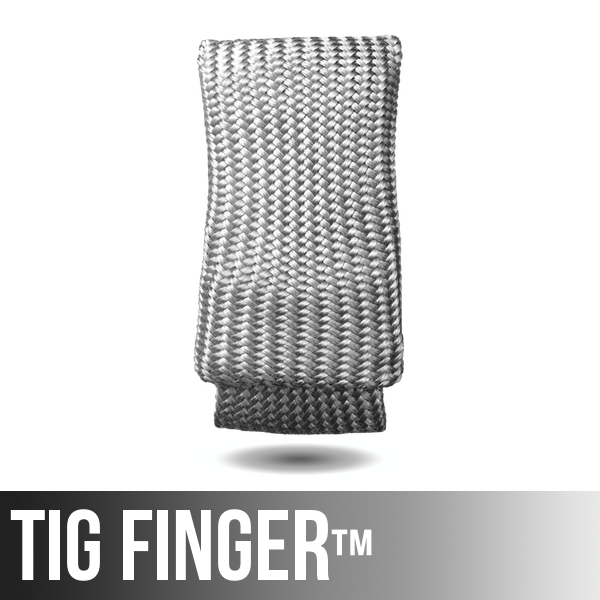BELOW IS THE NEXT VIDEO, FURTHER EXPLAINING WALKING THE CUP!
Video Transcript:
Walking the Cup – TIG Welding Technique
Today we’re talking about walking the cup. It’s a tig welding technique. What is it? What is it good for? When would you want to walk the cup? When would you not? What are its limitation? And then we’ll also compare some free handing to walking the cup. Before we get into it, I’ll say this much. It’s primarily for pipe welding. That’s where it really excels, you know, for pipe welding. But, there are some round parts where it comes in handy, too. Let’s do it.
We’re gonna do flat parts first. This is just a regular T-joint, a fill it weld. The first pass, you just wiggle it, barely, like this, to keep that tungsten pointed right in the root pass. Then, the second pass, if you were gonna do two passes, would be a little bit like this. You can see, even what I’ve done here is put some scratches in there. We’re gonna talk about that later. Some parts, that’s just not permitted, to scratch up a nice machine surface on something that’s got a super smooth finish on it. But, I’m gonna do it here, just for demonstration purposes. I’m using a 332, 2.4 millimeter wire here, using 332 electrode, this is 175 amps. I’m going to go ahead and weld the first three quarters of an inch or so there, whoop, engines.
Then, I’m going to stop and start walking the cup. That looks something like this, just aver subtle movement. You keep light pressure on the metal with the cup, you don’t want to bear down on it real hard or you can slip. Just enough pressure to keep it steady, and then wiggle it. When it breaks tension, when you’re wiggling the cup breaks tension it just progresses you forward just a little bit at a time. It’s a way of progressing your travel speed very evenly without having to prop on anything because the cup is propping on the metal. All right. That’s the first pass. We are going to go ahead and put another pass over that. You can see the little transition about a half inch in. I went ahead and welded about a half inch here freehand, before I start walking here, and I’ve increased the filler metal size and I’m using one eighth, 3.2 millimeter.
That looks something like this. It’s all about selecting the right cup size, the right electrode extension to get the right angle. That’s stuck out there pretty far, I guess you could say a rule of thumb, you don’t want to go too much farther than the inside diameter of your cup, but sometimes you do. All right. That’s a fill it weld with two passes. You see it gives you a nice, even rippled pattern if you do it right. Walking the cup is good for that. I did a run of 50 of these, where I had this flange to weld on the end of this tube here, and it was really easy to walk the cup, just like that, and I was a lot less tired at the end of it.
So far, we’ve more or less wiggled the cup inside the two walls of a fill it weld. We’re getting ready to walk the cup on a flat surface. All right, imagine this is your cup and electrode. It’s very much akin to walking a 55 gallon drum across a shop floor. You roll it one direction, you tilt it and roll it in the other direction, and so it helps to have a big cup for doing a wide weave on a cover pass of say, even something as small as six inch, schedule 40, a 12 cup is about the right size. Not only will you get better gas coverage, you just got to do a whole lot less wrist motion to get the width. And it looks just like the Taco Bell cup, doesn’t it?
It is important to get the right stick out of your electrode, and to use the right size cup, and maybe a rule of thumb is not to extend the electrode really much farther than the inside diameter of the cup. Sometimes you will have to hold the cup, and hold the torch in odd ways like this. Upside down, sideways like this, but just keep in your mind that it’s like rolling a 55 gallon drum. You have to turn it and roll it, and turn it and roll it, and that’s what … It’s also called a figure eight, or a lazy eight, but in my mind I’m rolling a drum across the floor. This is a one eighth filler rod here on some really heavy wall, stainless steel tubing. I’m about 130 amps, here’s a close up of that.
I’ve just scored some hash marks in there to resemble the walls of a pipe. We’ll get into some pipe welding later on this, but for now, it’s good to get the fundamentals down of just what walking the cup is. I’m using the lay wire technique here, you can dip in and out as long as you keep the tip of your rod shielded. Now, I’m going to try to do the same thing with the tig finger here. You can see right on the end there, right next to the weld, you can imagine that’s getting pretty hot on the metal, but my finger is not. What you’re trying to do here is mimic the same little weave motion. The angle is different because the angle of the electrode doesn’t point differently, it’s just straight across, but it gets the job done.
Here is a nice little close up of that. Just tying in those little hash marks that I’ve scored in there to resemble again, the bevels of a … Walls of a pipe. Again, about 130 amps here. I’m not in any hurry to get my hand off of there because it’s not even really warm. You can see that’s an option, and sometimes you have to do it because there is stuff in the way and you can’t walk the cup, it won’t let you move the handle around. Being able to freehand as well, is very helpful. Here’s a little quick 15 second commercial.
There is both my products. Tig finger. Tig finger XL. Both of them 100 percent sourced, and assembled in the USA. Assembled by friends and family.
You saw me just a second ago. This is the regular tig finger, the XL we’ll look at later, you can usually slip two fingers in the XL and it’s thicker. All right, we’ll move onto socket welds now. We’ll do a little cup walking here as well as some freehand. Again, this is just a little fill it weld, just like we did earlier, and you just wiggle it a little bit with light pressure. Don’t get a whole lot of width going on that first pass. Usually, you want to use a smaller diameter filler for that root pass to make sure you sink it in there good, and then maybe go up to a one eighth, 3.2 for the second pass. Again, it’s like doing this for the second pass. It’s a different technique for the second pass than for the first pass. It’s like rolling a drum across the floor.
All right, we’re going to take a look now at doing a little freehand action coming in from the top, with the tig finger XL slipped over two fingers. Heat rises and a little nipple like this can get really hot, really quick if you don’t have something to protect your glove. Your bare glove just doesn’t cut it. It’s jut an option, a lot of times socket welds, especially in shipyards, you know, in ships you just don’t have a lot of room, everything is tighter, so it’s rare to be able to walk the cup on something like this inside of a ship.
Here is a job I did several years ago, and here’s a little trick her on a ground clamp too. If you can’t get ground clamp on something use some bare, copper, braided wire like that, it really works, really well. This is a job I was able to walk the cup on because the machinist was going to take a little skim cut anyway and radius that. But, sometimes you can’t walk the cup, if he wasn’t going to take a skim cut off of that I wouldn’t have wanted to put those scratches on there if that surface was going to be left as is.
This is an example of where I would have liked to walk the cup, because it was so hot, but again, a nice finished machine surface, the machinist didn’t want those scratches on the part to deal with and have to buff out, os I didn’t do it. I pre-heated it to 500 degrees, propped with the tig finger, and did little free hand pass like this at about 170 amps for the first pass, and then came over it with a second pass about the same heat, maybe 5 or 10 more amps. Just a nice little freehand weave pass. Tried to make it look as nice as possible. I would have loved to walk the cup on this, it would have probably looked a lot nicer, but it did come out okay.
The moral of the story is, sometimes you can walk the cup, and it’s a great technique, sometimes you can’t. It’s great to know both techniques to be able to do both. Sometimes the metal gets super hot and a tig finger comes in super handy.I appreciate your support and I appreciate you watching. My online store is at Weldmonger.com. See you next time.







Leave a Reply